What comes to mind when I say, “Mediterranean style”? I think of clear blue skies with distant vistas; warm air scented with sage and lavender; a certain stillness broken only by the gentle splashing of a cooling fountain; weathered terra-cotta urns; and long, lazy lunches with good friends, good food and good wine under an arbor covered in grapevines. All of which is about as far away from a description of Seattle, where I live, as you can get. Or is it?
On a recent tour organized by the Northwest Horticultural Society, a group of excited members were invited to visit the tranquil oasis created by designer and homeowner Sue Tong and her family. The sunny weather certainly played into the illusion of our being transported to Tuscany or Provence that day, but it was the garden design itself that made us feel as though we had traveled to another country.
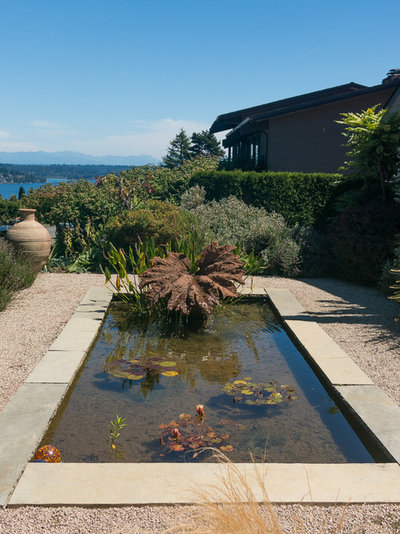
Le jardinet
The scene was set as soon as we stepped off the curb and entered the front garden, where a gunnera (
Gunnera sp)
leaf sculpture by artists Lewis and Little presided over a long reflecting pool. The distant view of Puget Sound teased the senses as I began to imagine the deep blue waters of the Mediterranean.
As lovely as that was, it was the back garden that truly captured my imagination. It was a masterful blend of those elements that represent Mediterranean style, yet they were tastefully adapted to the Pacific Northwest climate, creating a comfortable, nonpretentious space that will stand the test of time.
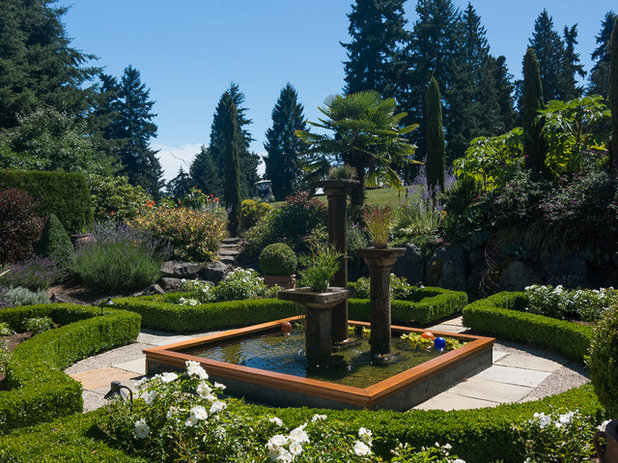
Le jardinet
How to Get the Look
Create a sense of space. The back garden is actually a fairly small space, 125 feet by 75 feet, divided between a stone terrace and planted areas, but several design tricks have been used to fool the eye into thinking it is much larger.
The garden backs onto a golf course, but rather than erecting a fence on the property line, the homeowners planted a row of carefully spaced
Italian cypress trees (
Cupressus sempervirens, USDA zones 7 to 10; find your zone). These create a series of long windows through which we can glimpse what appears to be a distant view of rolling hills. If these trees are not hardy in your area, you could substitute another columnar conifer, such as
arborvitae (
Thuja occidentalis, zones 3 to 8) or
green juniper (e.g.,
Juniperus chinensis ‘Hetzii Columnaris’, zones 4 to 9).
Strong geometry is the second trick used to visually expand this garden. A formal parterre has been created by two intersecting paths, their axis drawing our eyes easily through the space.
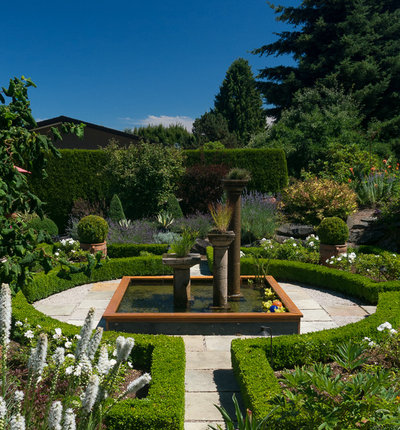
Le jardinet
Add the sound of water. The centerpiece of the parterre is a shallow, square reflecting pool in which stand three water columns by sculptors Lewis and Little. The columns have an aged appearance, reminiscent of ancient ruins, which adds a fun sense of history to the relatively new space.
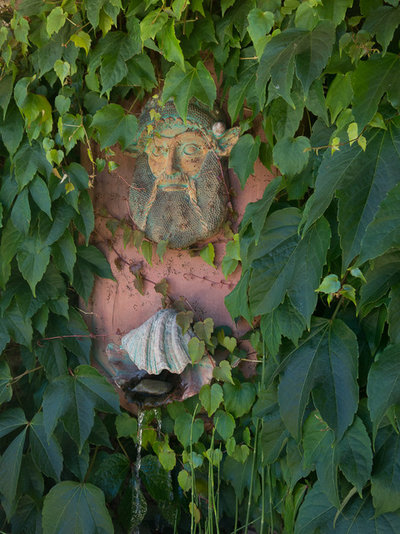
Le jardinet
A second fountain by the same artists sits to the side of the main terrace, this time tucked into a vine-smothered wall that had me seek out the source of the softly dripping water.
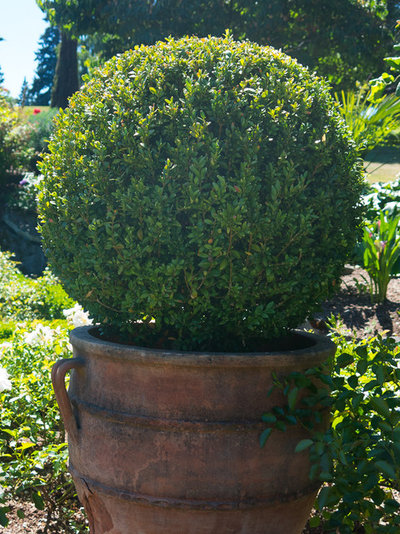
Le jardinet
Choose the plants carefully. Rather than using a palette of true Mediterranean species throughout the garden, many of which would not be reliably hardy here, the designer looked to the style, textures and colors of those plants and created a similar look.
Boxwood (
Buxus spp) has been used extensively to define the geometry, either clipped into tidy low hedges or as topiary cones and spheres in pots. Some varieties of boxwood are hardy to -30 degrees (zone 4). Several varieties of Japanese holly (
Ilex crenata) could also have been substituted.
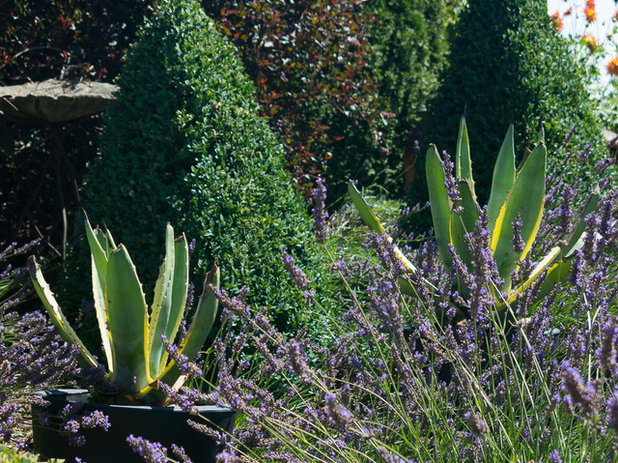
Le jardinet
Drought-tolerant plants predominate, with the evocative lavender (
Lavandula sp)
perfuming the air, just as we anticipated.
Less hardy plants, such as
agave, have been kept in containers for easy overwintering indoors.
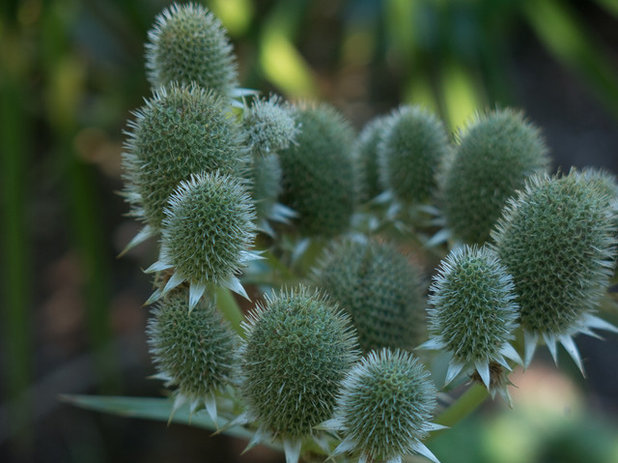
Le jardinet
I am especially fond of sea holly (
Eryngium spp) and loved the texture of this one, which I had not seen before. I believe it is
agave-leaf sea holly (
Eryngium agavifolium), which, despite its tender appearance, is in fact hardy to -10 degrees (zones 6 to 9).
Other than the lavender, most of the flowers are white, with white roses filling the parterre and white gayfeather
(
Liatris spicata ‘Alba’) and other perennials adding occasional accents.
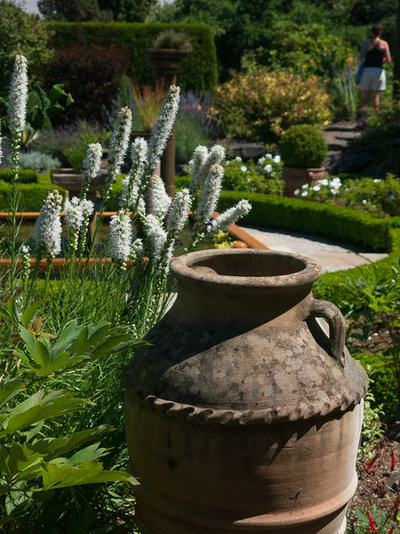
Le jardinet
Use the right container style. Weathered terra-cotta containers are used throughout the garden, either left empty or planted with boxwood. Terra-cotta is porous and will crack in a hard freeze. I suspect the empty ones are protected during the winter, while those planted with boxwood are either left to chance or perhaps wrapped in situ with layers of burlap and Bubble Wrap.
See ways to beat the frost with terra-cotta containers
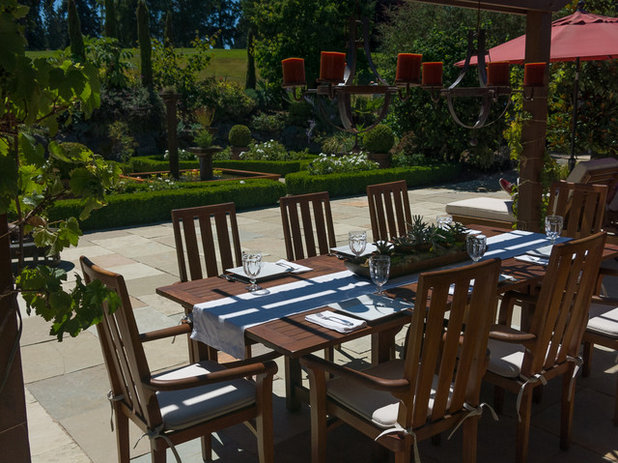
Le jardinet
Add the finishing touches. What better way to enjoy the garden than to sit with friends? Simple teak furniture on a paved stone patio in mellow tones is a classic look that crosses many style boundaries. Crisp white linens and a low succulent planter dress up the table without trying too hard to look Tuscan.
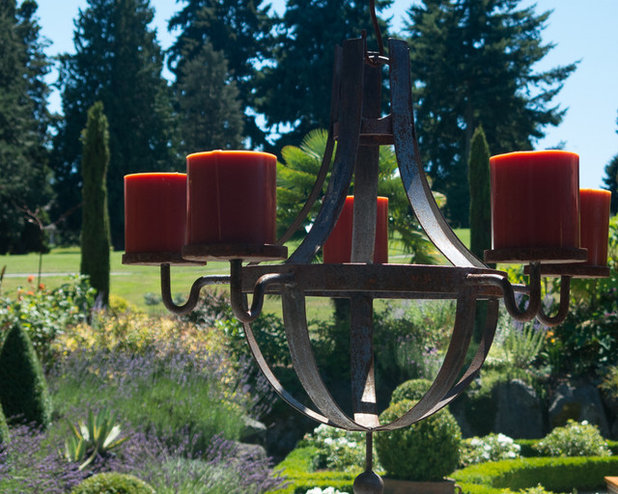
Le jardinet
Good design is always in the details, and this pair of rustic metal candelabras completes the scene. The rich mahogany candles tie in well with the colorful umbrella set off to one side.
From start to finish, this garden is exquisitely thought out, yet it does not feel stiff. The designers have achieved a remarkable interpretation of a relaxed Mediterranean style in a Pacific Northwest climate.
More: Lay of the Landscape: Mediterranean Garden Style





